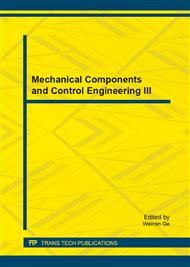p.205
p.209
p.213
p.217
p.221
p.226
p.230
p.236
p.240
On the Force of Rotor-to-Stator Element Radial Rubs in Rotating Machinery
Abstract:
Rubs between stator and rotor are the most common and destructive faults in starting or running of rotating machinery. Force of radial rubs is the main parts of rubbing system dynamic models, and determines their accuracy directly. Force model is very important for fault diagnosis in theories and its applications. The recent studies on force models of radial rubs are introduced. Their modeling theories and its applications are summarized. The used conditions and applications scopes are analyzed mainly. The advantages and disadvantages of different models are discussed. It is pointed out that describing rubbing force accurately and building useful models will be the future studies, based on rational theories, considering environment factors, choosing all kinds of parameters affected to models.
Info:
Periodical:
Pages:
221-225
Citation:
Online since:
October 2014
Price:
Сopyright:
© 2014 Trans Tech Publications Ltd. All Rights Reserved
Share:
Citation:


